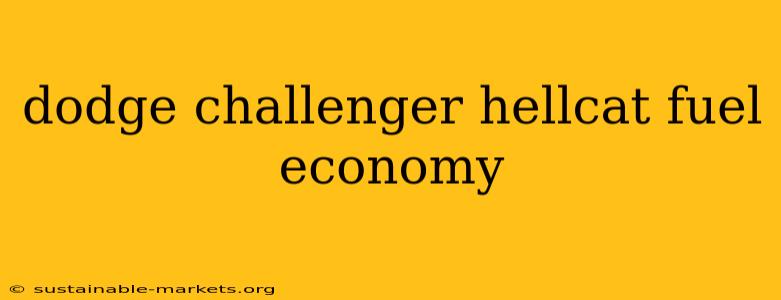The Dodge Challenger Hellcat. The name alone conjures images of raw power, aggressive styling, and tire-shredding acceleration. But what about fuel economy? Let's be honest, when you're dealing with a supercharged 6.2-liter V8 producing over 700 horsepower, MPG isn't typically the first thing on anyone's mind. However, understanding the Hellcat's fuel consumption is crucial for potential buyers and enthusiasts alike. This in-depth guide will explore the official EPA estimates, real-world fuel economy experiences, and factors influencing fuel efficiency in this iconic muscle car.
EPA Estimates vs. Real-World MPG: The Reality Check
The official EPA estimates for the Dodge Challenger Hellcat (depending on the year and specific model) typically hover around 12 MPG city and 22 MPG highway. These figures represent idealized driving conditions and rarely reflect the experience of the average driver.
Real-world fuel economy is often significantly lower. Many owners report achieving MPG figures closer to 10 MPG in city driving and 15-18 MPG on the highway, depending on driving style and conditions. Several factors contribute to this discrepancy:
- Aggressive Driving: The Hellcat's immense power tempts even the most disciplined drivers to unleash its full potential. Hard acceleration and high speeds dramatically reduce fuel efficiency.
- Traffic Conditions: Stop-and-go city traffic significantly impacts MPG, as the engine is constantly working to overcome inertia.
- Environmental Factors: Weather conditions, such as extreme heat or cold, can also influence fuel consumption.
- Vehicle Maintenance: Proper maintenance, including tire pressure and regular tune-ups, plays a role in optimizing fuel efficiency.
Factors Affecting Dodge Challenger Hellcat Fuel Economy
Several key factors significantly impact the fuel economy of your Hellcat:
Driving Habits: The Biggest Influence
Your driving style is arguably the most impactful factor. Gentle acceleration, maintaining consistent speeds, and avoiding aggressive braking will significantly improve your MPG. Conversely, lead-footed driving will quickly drain your fuel tank.
Vehicle Condition: Maintenance Matters
Regular maintenance is crucial for optimal performance and fuel efficiency. Ensure your tires are properly inflated, your engine is tuned correctly, and all other systems are functioning as intended. Neglecting maintenance can lead to decreased MPG and potential mechanical issues.
Terrain and Road Conditions: Hills and Headwinds
Driving in hilly terrain or against strong headwinds will naturally increase fuel consumption. Similarly, driving on rough or unpaved roads requires more power from the engine, leading to lower MPG.
Modifications: Aftermarket Upgrades and Their Impact
Aftermarket modifications, such as performance upgrades or larger wheels and tires, can either improve or worsen fuel economy, depending on the specific modification and its impact on the vehicle's overall performance. Always research the potential effects of any modifications before implementing them.
Tips for Improving Hellcat Fuel Economy
While the Hellcat isn't designed for optimal fuel efficiency, you can still take steps to improve your MPG:
- Drive smoothly: Avoid aggressive acceleration and braking.
- Maintain consistent speeds: Cruise control can be helpful on long highway drives.
- Keep tires properly inflated: Proper tire pressure improves fuel efficiency and handling.
- Regular maintenance: Ensure your vehicle is in top condition.
- Consider driving habits: Be mindful of your driving style and its impact on fuel consumption.
Conclusion: Expect the Unexpected (and Embrace It)
The Dodge Challenger Hellcat is not a fuel-efficient vehicle. Its purpose is to deliver exhilarating performance, not exceptional MPG. While understanding and potentially improving fuel economy is helpful, accepting that it will likely remain relatively low is key to owning and enjoying this powerful muscle car. The thrill of driving a Hellcat often outweighs the cost of filling its large fuel tank.

